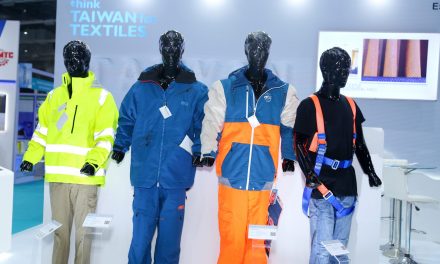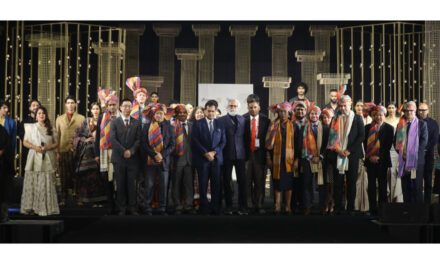 In the quest to make the textiles sector more efficient and less polluting, AEPC kick started its drive on sustainability and circularity to boost the competitiveness of garment exports globally. Towards kick starting this initiative, AEPC organized a brain storing session on “Promoting Circularity amongst Indian Garment industry” on 27th July 2022 at Apparel House, Gurugram today. AEPC has partnered with Fashion for Goods, Netherlands, for this initiative. U. P. Singh, Hon’ble Secretary, Textiles made a special address during the session. The prominent industry leaders of garment trade and other stakeholders were present in the meeting.
In the quest to make the textiles sector more efficient and less polluting, AEPC kick started its drive on sustainability and circularity to boost the competitiveness of garment exports globally. Towards kick starting this initiative, AEPC organized a brain storing session on “Promoting Circularity amongst Indian Garment industry” on 27th July 2022 at Apparel House, Gurugram today. AEPC has partnered with Fashion for Goods, Netherlands, for this initiative. U. P. Singh, Hon’ble Secretary, Textiles made a special address during the session. The prominent industry leaders of garment trade and other stakeholders were present in the meeting.
This brainstorming session conducted with the support from Fashion for Good, Netherlands, involved all the stakeholders engaged in the garment value chain including Brand Partners (PVH, Adidas, LS&Co, TESCO, Target, Primark), Supply Chain Partners: Arvind, Birla Cellulose and Welspun India), Pre-consumer pilot stakeholders: 20 manufacturers, Technology Innovators: Reverse Resources, Matoha, Picvisa, etc.
During his address Secretary Textiles lauded the AEPC initiative and congratulated the entire team. He said,” Sustainability and circularity is not new to the country. The magnitude of waste in landfill which is presumed to be 80% is due to the textiles waste is wrong. What is comforting to us is that almost 59% is recycled and reused.” Further, the secretary remarked, the government is ready to help the industry with incentives, relevant interventions, standardization and policy support to build a viable ecosystem for a sustainable and circular economy.
Making the opening remark, Naren Goenka, Chairman AEPC said, “The major issue which has gained the attention of the global consumers is the landfill contribution made by the textile waste both at pre and post-consumer stage. Approximately, 50 per cent of the fabric is wasted during the manufacturing process and the fast fashion trends leads to 81% of all manufactured garments getting dumped as landfills either due to short life cycle after consumer use or due to excess stock.”
With global apparel market size expected to grow from $551.36 billion in 2021 to $605.4 billion in 2022 to $843.13 billion in 2026, depicting a growth of 8.6% and the Ministry support through government incentives, PLI and PM-MITRA, India with its core strength on availability of variety of raw material with minimal import dependence leading to short lead times, becomes a preferred manufacturing hub for the major international brands and retailers, Chairman AEPC added.
Hence, AEPC parallelly needs to take the responsibility of the severe ecological and environmental hazards associated with the garment industry which enhanced domestic manufacturing is expected to bring in. Further, AEPC has focused strategy towards encouraging wider penetration of these measures amongst the MSMEs hand holding these units with demonstrations and solutions, sustainability awards, branding efforts etc.
We are happy to share a recent initiative taken by AEPC for promoting the concept of circular economy approach. The initiative would assist the Indian garment manufacturers to achieve their circularity goals by addressing problem areas including agricultural waste to textile, Chemical recycling of textile, Textile waste, Alternate leather, regenerative agriculture, Wastewater, Plastic recycling and Traceability in the textile supply chain, Chairman AEPC underlined.
Approximately 7793 kilo tons are accumulated in India every year which is 8.5% of the global textiles waste. 59% of this waste finds its way back into the textiles industry through reuse and recycling. Out of the total 1490 kilo tons which is 19% is being downcycled by the secondary industries like automobiles, bedding and wipes industry. 1347 kilo tons of the total which is 17% only reached landfills.
India has a well- networked textiles waste value chain through organized, enabling transfer of waste across the country. However, lack of traceability system, excessive cost competitiveness, limited infrastructure to process certain waste types and workers well-being has limited potential of a circular value chain.
The estimated loss of approximately 0.70 USD for every piece of apparel exported. To trace the destination of waste, it has been found that approximately 15 tons of informal trading of wastes took place in a single underground market. Overall, it leads to a significant loss of value addition that could have been added through a circular economy. The idea is to convert this waste to wealth which promises a huge business opportunity for those engaged in the domain.
To the follow-up of this session AEPC proposed to organize a ‘Sustainability Conclave’ later this year, Chairman AEPC announced.

















